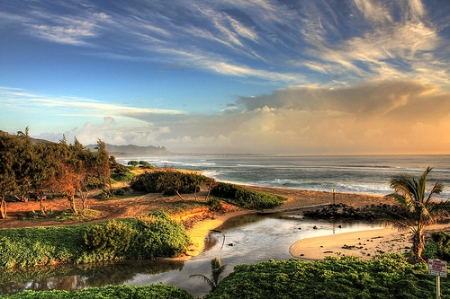Isolation has its merits, but in Hawaii the same seclusion that lures planeloads of tourists also severs the state from its sources of energy.
While the rest of the country’s transportation system relies almost solely on oil, Hawaii remains heavily dependent on petroleum for nearly 90 percent of all its energy needs, including electricity generation. The state’s four largest plants — and 9 of the 10 largest — are primarily powered by petroleum. The amount of oil arriving by ship is of great concern for a state that values its environment and the tourism dollars that come with it. But the energy mix has also led to backbreaking electricity rates that are twice as high as the next costliest state and nearly three times the national average.

Those rates — 34.58 cents per kilowatt-hour for residents — are part of the reason behind the state’s aggressive push to get to 70 percent renewable energy by 2030 including transportation and 40 percent for renewable electricity generation. (The security dangers of being so heavily reliant on one source certainly factors into the RPS.) While wind and solar have increased their contributions to the energy mix in recent years, the state’s largest utility is now looking to biofuel as a way to achieve the state mandates without building new power facilities.
Building a Market
In the latest in a string of announcements, Hawaiian Electric Company and Hawaii BioEnergy have struck a 20-year deal to blend 10 million gallons per year of biofuel grown and processed on the island of Kauai and shipped to Oahu, where it will be used at the 650-MW Kahe Generating Station, the largest plant in Hawaii. The biofuel would then be blended with low sulfur fuel oil. The contract still needs approval from the Hawaii Public Utilities Commission (HPUC) as well as input from consumer groups.
According to Hawaii BioEnergy, a consortium of some of the state’s largest landowners, the crops for the biofuel will be grown on largely fallow and underutilized land. On Tuesday, Joel Matsunaga, Chief Operating Officer and Executive Vice President for Hawaii BioEnergy, said the company is looking at eucalyptus for its 14,000 acres on Kauai, but the company is willing to consider other types of feedstock and is also exploring the possibility of adding more land it owns on other islands if the opportunity arises.
The agreement calls for 1 million gallons of a test batch to be delivered 4 years after HPUC approval and the full 10 million gallons would be delivered annually 1 year after that. If the 10 million agreement is fulfilled, utility officials say it will represent about 4 percent of the plant’s current fuel use.
The 10 million gallon contract is part of the company’s April call for proposals for up to 42 million gallons of biofuel. Hawaiian Electric already has a deal with Aina Koa Pono for 16 million gallons per year on 15,000 acres on the Big Island of Hawaii. That company would clear invasive species as the first feedstock, and then perhaps look to switchgrass to produce biodiesel for a petroleum diesel plant. Another project led by Pacific Biodiesel will create an 8-MW power plant that will run entirely on locally recycled restaurant oil. The Honolulu International Airport Emergency Power Facility is expected to come online in 2012.
The deal announced this week comes on the heels of a groundbreaking of a Honeywell demonstration facility that will convert forest residuals, algae and other cellulosic biomass into biofuels intended for the transportation market.
Getting to 40 Percent
The movement in Hawaii is not without its hurdles in selling the idea to both environmentalists and the business community. According to Aina Koa Pono, its deal with Hawaiian Electric has been met with concern over the effects the operation could have on property values, traffic and the town’s serenity. There have also been questions about a perceived lack of transparency over costs for the fuel. Published reports have stated that Hawaiian Electric does not disclose price structures, with the utility arguing that doing so could compromise future negotiations.
“In the short-term, it’s inevitable that it will be more expensive,” said Hawaiian Electric Spokesman Peter Rosegg on Tuesday. “Long-term, these are fixed-price contracts. I believe that as the price of fossil fuels continues to rise that we’ll be paying less 15 years out.”
Rosegg said his company is looking to biofuels to fill perhaps 10 to 15 percent of the energy mix, with wind, solar, geothermal and perhaps emerging ocean and wave technology taking up the remainder of the 40 percent renewable target. Such an ambitious state goal means the local utilities may remain in flux as they search for the right combinations and the right industries to deliver those numbers.
How that impacts rates a decade from now is anyone’s guess. The realization is that anytime you move from one energy system to another, it’s going to be expensive. There’s also the realization that no matter Hawaii’s future energy mix, the state is likely to maintain it’s unenviable ranking for most expensive energy.
“We have a thing in Hawaii called the paradise tax, which means that basically anything you look at is 25 percent more expensive because everything needs to be shipped out,” said Rosegg. “We’ll always be in a high-priced market. But even if you take a dollar that we’re spending on oil and you spend it at home instead of sending it to Saudi Arabia, then that dollar will stay here.”
 Follow
Follow